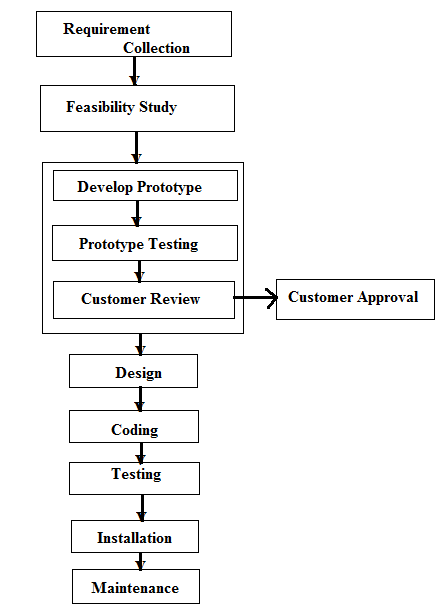Introduction to software development life cycle (SDLC)
Chapters
Prototype model of SDLC
In this Prototype Model before designing phase, a prototype is developed, tested, reviewed and approved by the customer, after that design will be ready for coding, testing, installation and maintenance will takes place. This prototype is prepared based on the customer requirements. Prototype testing is checking for the required components are present or not.
By using this prototype, customer can understand the requirements of desired system and also the customer can get an “actual feel” of the system. It is an attractive idea for complex and bigger systems.
Prototype Diagram:

This Prototype Model is same as waterfall model, but in this model we need to develop prototype and customer interaction will be there. Since there is customer interaction there will be less chance of rejection.
When to use Prototype model:
- Whenever the customer not clears about the requirement in this situation we generally go for prototype model.
- If it is complex project then prototype model makes clear understand the requirement.
- Prototyping make sure that the customer constantly work with the system and provide a feedback about the system.
Advantages of Prototype model:
- Customer satisfaction exists, because customer can feel the product at very early stage.
- If there is missing functionality can be identified easily
- There will be less chance of software rejection.
- Requirement changes are allowed.
- Due to customer approval we can find the errors at early stage.
- Customer involvement will be there in the development where its leads to better solutions for any confusion / complexity / difficult functions
- The developed prototype can be re-used by developer and test engineer.
Disadvantages of Prototype model:
- There are no parallel deliverables
- It is a time consuming if customer ask for changes in prototype
- This methodology may increase the system complexity as scope of the system may expand beyond original plans.
- The invested effort in the preparation of prototypes may be too much if not properly monitored.
- Customer may get confused in the prototypes and real systems.
In the next chapter we will know a bit about the V-model
Description
This tutorial covers
- What is SDLC
- Waterfall Model
- Spiral Model
- Prototype Model
- V-Model
- Iterative model
- Big Bang Model
- RAD Model
- Agile Model
- Useful resources to futher your understanding on SDLC
Report any errata directly using our support forms
Audience
Beginners looking to get their hands on understanding of software development life cycle (SDLC)
Learning Objectives
A quick introduction to SDLC
Author: Subject Coach
Added on: 30th Jul 2015
You must be logged in as Student to ask a Question.
None just yet!